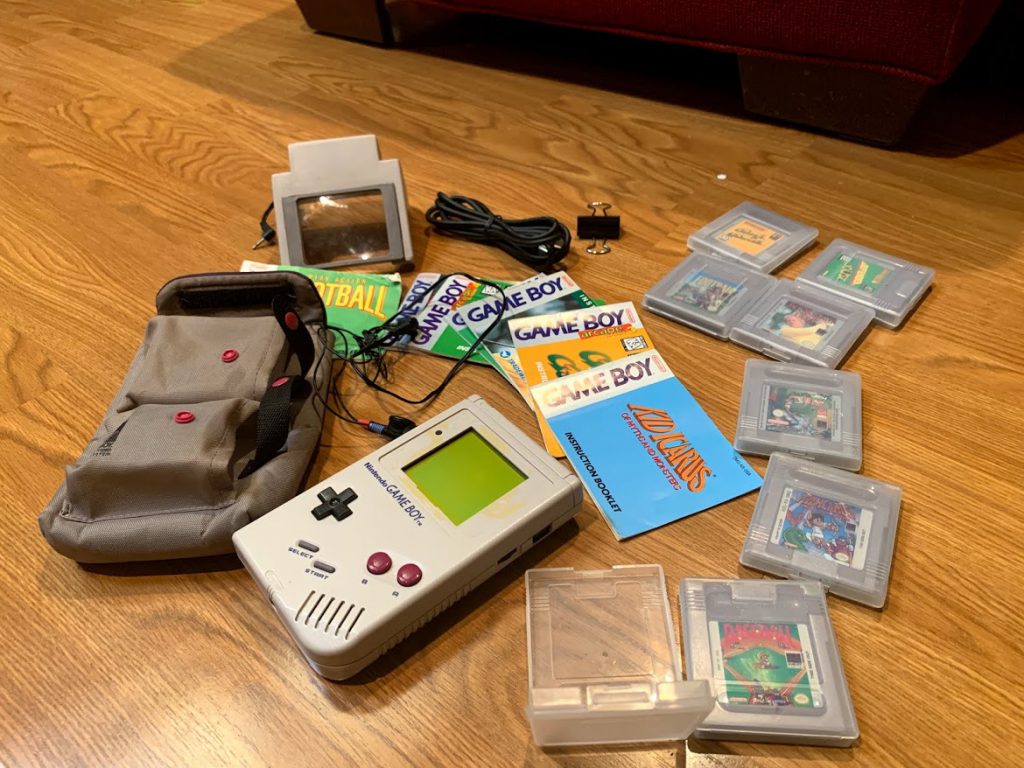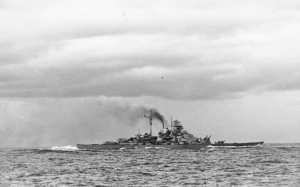Chances are that at one point or another in your life, you have heard of Nintendo. The company of Nintendo launched in Japan in 1889 as a card game company. However, Nintendo is now a video game company. As pinball machines gave way to electronic video games, the toy industry sought to take video games into the home with console games that plugged into televisions. The next step was to be able to take the game along for the ride. With that in mind, Nintendo created a gaming system then called the Game Boy.1
Gunpei Yokoi developed Nintendo Game Boy. The first version of the Nintendo Game Boy was made in 1989 and “offered a Z80 processor, a green LCD screen, and a gray hard-shell body.”2 The Nintendo Game Boy was one of the first handheld video game consoles. Roughly the size of a paperback book, the Game-boy utilized game cartridges and greyscale dot-matrix graphics.3 The Nintendo Game Boy was paired with a game called Tetris, a tile-based puzzle game, which made the Nintendo Game Boy an instant success.4 When the Nintendo Game Boy released in Japan, 300,000 units sold. A few months later, the Game Boy was released in the United States on July 31, 1989. The development of Nintendo Game Boy did not stop after its release, but the gaming unit went through many changes over a ten year period.5

While there were other handheld video game consoles on the market, the Game Boy was one of the first to feature interchangeable cartridges. Other handhelds only had one pre-installed game. In other words, if you wanted to play different games, you had to purchase separate consoles. My mother’s family talks about going on camping trips with the cousins’ football and baseball handheld video games, which was just about all there was at the time before the Game Boy. The Game Boy allowed the user to purchase one console and multiple (sometimes hundreds) of game cartridges. Not only was this a new idea, but it was a very profitable one as well.
Not only did Game Boy users purchase game cartridges, they also bought all sorts of accessories. Users needed cases to carry their console and cartridges. They purchased gadgets to magnify the screen. They also purchased gadgets to use the console in low light conditions due to no backlighting for the Game Boy. And, of course, users sought to upgrade to the next best console as Nintendo continued to develop new products.
One of the many modifications to the Nintendo Game Boy was the Mini-Arcade. The Mini-Arcade turned a user’s Game Boy into a table top game. It included a miniaturized version of the joystick which was used in other standard gaming consoles.6 The Mini-Arcade addition made the Nintendo Game Boy something that people could use as a table top game if the user so desired.
Another modification that the Nintendo Game Boy has gone through is having different colors of casing. By 1995, users had a choice of body colors for their Nintendo Game Boys.7 One option included the “Play It Loud” colors. Play It Loud was a campaign that showed different colors they offered for the Game Boy. The different colors that “Play It Loud! units were manufactured were red, green, black, yellow, white, blue, and clear.”8 The clear or transparent Game Boy, sometimes called X-Ray, could be found in the UK during this time. One source describes, “The most common Game Boy colors included yellow, red, clear and black. The Green Game Boy were fairly scarce but blue and white are the rarest.”9 There were other accessories that Nintendo put out such as a printer and a camera in 1995. They also toyed around with a 16-bit version the same year the printer and camera accessories were out and considered making a touch pad adapter three years after.10
A third revision to the Nintendo Game Boy was the Game Boy Pocket, which was released on July 21, 1996. The Game Boy Pocket boasted a version that was smaller and lighter when compared to the original Game Boy. Advertisements highlighted the fact that this console could fit in your pocket. Another advantage of the console was that the gaming cartridges were interchangeable with the original Game Boy. Unlike the original Game Boy, which required 4 AA batteries to function, the Game Boy Pocket only required 2 AAA batteries to function. While the Game Boy Pocket required fewer batteries to function, it could only provide the user of the console with about ten hours of game play compared to the original Nintendo Game Boy which yielded about fifteen hours of game play.11 With the Nintendo’s many revisions and iterations such as the Game Boy Pocket and Game boy Color, the Game Boy sold over 118 million units worldwide.12

Another revision was the Game Boy Light, released in Japan on April 14, 1998, which was only available in Japan. The Game Boy Light was a console that was slightly bigger than the Game Boy Pocket. The Game Boy Light offered a feature that the previous versions of the Game Boy did not have which was “an electroluminescent back light for low-light conditions.”13 The Game Boy Light requires 2 AA batteries to function providing the user of the console with about twenty hours of game play without the electroluminescent back light on and twelve hours of game play with the electroluminescent back light on. The Game Boy Light had two standard colors, gold and silver. It also has “numerous special editions, including an Astro Boy edition…, an Osamu Tezuka World edition with a clear red case and a picture of his characters, and a solid yellow Pokemon Center Tokyo version.”14
The Game Boy Color is yet another version of the Game Boy, which was released in Japan on October 21, 1998, and a month later, it hit the international markets. Compared to the other versions of the Nintendo Game Boy the Game Boy Color had a screen that could display images in color. Unlike the Game Boy Light, which had a electroluminesent back light to use in low-light conditions, the Game Boy Color did not have one. The Game Boy Color required 2 AA batteries for providing the user with 10 hours of game play. The Game Boy Color also utilized backwards compatibility, featuring the ability to play gaming cartridges originally developed for the original Game Boy and Game Boy Pocket. Unique colors of this version of the Game Boy included berry (fuchsia), grape (purple), kiwi (neon green), dandelion (yellow), and teal. Two other options sold at the same time were called Atomic Purple, which was a translucent purple color, and Neotones Ice which was a clear casing that was only sold in Japan. The original Game Boy and the Game Boy Color sold about 118 millions unit worldwide.15

The Game Boy Advanced SP was yet another version of this system, and it was released in February 2003. The Game Boy Advanced SP included a screen that could show pictures in color, a front light which could be used in low light conditions, and a clam shell design to protect the screen from getting damaged or dirty. The clam shell design was also used in the Nintendo DS, which was released in November 2004. The Game Boy SP had a rechargeable battery, which took three hours to recharge, provided the user with 18 hours of gameplay without the light on and 10 hours of gameplay with the light on. Compared to the other Game Boy consoles that came before it, the consoles that came after the Game Boy Advanced SP had better, more colorful graphics, gaming mechanics were made more complex by adding voice control and touch screen, and games with more moving parts could be more easily covered.16
The Nintendo Game Boy was not the only handheld gaming console to accommodate various game cartridges, but it was by far the most popular and longest lasting. Atari and Sega both introduced handheld consoles, but they were not able to innovate to the level that Nintendo could. Nintendo continues to dominate the world of the full-size video game industry while incorporating online gaming. While handheld consoles are not as popular due to the proliferation of smartphones, the Game Boy influenced app-based games and ingrained the idea that we can take the game with us.
- “Nintendo of America Inc.,” in Company Profiles for Students, edited by Donna Craft and Amanda Quick, Vol. 2. (Detroit, MI: Gale, 1999)950-954. ↵
- Elizabeth Rholetter Purdy, “Gameboy,” in St. James Encyclopedia of Popular Culture, 2nd ed., edited by Thomas Riggs, Vol. 2. (Detroit, MI: St. James Press, 2013), 420. ↵
- “Nintendo of America Inc.,” In Company Profiles for Students, edited by Donna Craft and Amanda Quick, 950-954, Vol. 2. Detroit, MI: Gale, 1999. ↵
- Roberto Dillon, The Golden Age of Video Games: The Birth of a Multi-Billion Dollar Industry (Boca Raton, Fla. : A K Peters/CRC Press, 2011), 164-165. ↵
- Wikipedia, 2019, s. v. “Game Boy,” https://en.wikipedia.org/wiki/Game_Boy. ↵
- Elizabeth Rholetter Purdy, “Gameboy,” In St. James Encyclopedia of Popular Culture, 2nd ed., edited by Thomas Riggs, 420. ↵
- Elizabeth Rholetter Purdy, “Gameboy,” In St. James Encyclopedia of Popular Culture, 2nd ed., edited by Thomas Riggs, 420. ↵
- Wikipedia, 2019, s. v. “Game Boy,” https://en.wikipedia.org/wiki/Game_Boy. ↵
- Wikipedia, 2019, s. v. “Game Boy,” https://en.wikipedia.org/wiki/Game_Boy. ↵
- Jeff Ryan, Super Mario: How Nintendo Conquered America (New York: Penguin, 2011), 207-208. ↵
- Wikipedia, 2019, s. v. “Game Boy,” https://en.wikipedia.org/wiki/Game_Boy. ↵
- Roberto Dillon, The Golden Age of Video Games: The Birth of a Multi-Billion Dollar Industry (Boca Raton, Fla.: A K Peters/CRC Press, 2011), 164-165. ↵
- Wikipedia, 2019, s. v. “Game Boy,” https://en.wikipedia.org/wiki/Game_Boy. ↵
- Wikipedia, 2019, s. v. “Game Boy,” https://en.wikipedia.org/wiki/Game_Boy. ↵
- Wikipedia, 2019, s. v. “Game Boy Color,” https://en.wikipedia.org/wiki/Game_Boy_Color. ↵
- Wikipedia, 2019, s. v. “Game Boy Advanced SP,” https://en.wikipedia.org/wiki/Game_Boy_Advance_SP ↵



41 comments
Aidan Farrell
This was an amazing reading piece. The Gameboy is probably one of the most important games consoles of all time, only being beaten out by the Nintendo Entertainment System, or NES. I like how you did not just focus on the original 1989 Gameboy, but ventured out into its sequels, such as the Gameboy Color and Gameboy Advance. Well done
Ian Mcewen
gaming has grown from a passing interest for programmers into a billion dollar industry, it has gone through many phases some good and some bad. the early years was the starting to figure what could possibly be done with the hardware, the middle was experimentation with what types of games could be sold some did some didn’t, now it has become stagnant and formulaic with companies not wanting to try something new in exchange just rehashing their IPs.
Evangelina Villegas
This article is really good and well written and it is also very informative on the history of the Gameboy. The Gameboy was something that I constantly played throughout my childhood and it was interesting to read about it’s long history and how it changed alson with the changes in technology. It just shows how much change that the Nintendo company goes through with their gaming consoles to keep up with the times and still be unique.
Jake Faryniarz
This is a very well written article about Nintendo and how the Technology has changed overtime. I have been playing Nintendo games since I was a little kid and owned one of the original Gameboys. It is crazy to believe how much of a jump we have taken in the technology industry and how much we are able to do because of it. I amazes me to see how the basic Gameboy has transformed into the advanced Nintendo switch. This article was very fun to read and I really enjoyed learning about Nintendo and how advanced their technology has become.
Janie Cheverie
The Nintendo company was always been a big part of my childhood. This article brought into perspective how much technology has evolved particularly in the gaming world. I didn’t know very much about the Nintendo Gameboy which made this article very interesting. It’s crazy to think about how the company went from the Nintendo DS to the technology in the Nintendo Switch.
Cailtin Egolf
I myself personally don’t enjoy or see the point of playing video games but my boyfriend plays a lot so I learned to appreciate it more. Reading this article also showed me how the process really went. I did however have a Nintendo when I was a kid that I enjoyed playing and grew up on the concept of it.
Sophia Rodriguez
The Nintendo Company had always been big since I can even remember. I never knew so much about any of the previous consoles like the first one the Nintendo Game Boy. I love how this one game was able to transform so much in the world and how they kept building others based on this one project. I remember how amazing the D.S was when I was younger and how everyone would be asking what color and games they had. This was an amazing article to read.
Reynaldo Rodriguez
When I first started reading this article my mind instantly sent me back to when I was a little kid going over to my best friends house and playing on our gameboys since it was the console that we both had. Those are some of the best memories that I will cherish for the rest of my life. Since those days the technology that Nintendo has used keeps upgrading and providing us consumers with better products for us to enjoy as well as for us to show the new generations what we had back in the day.
Kennedy Arcos
This article was very interesting and it honestly brought back so many memories. Growing up, my cousins and I shared a Nintendo Game Boy, and we each later got the Nintendo DS. I think it’s crazy how far technology has come and how Nintendo now has newer gaming systems. I also enjoyed this article because it helped me learn more about the different versions of the Nintendo Game Boy. Great read!
Mia Hernandez
Growing up my sister and I played with the Nintendo GameBoys that had actually been my parents when they were growing up and we absolutely loved them. This article reminded me about how far we have come technologically in the gaming area. To go from something as simple the original Nintendo GameBoy to as complex as the new Nintendo Switch is amazing for both consumers and Nintendo, as they are continuing to put out merchandise that the community will love.